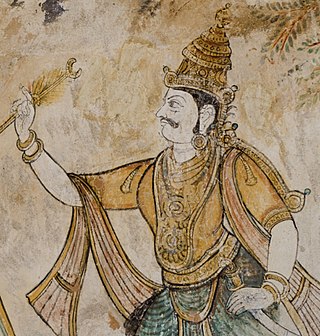
Rajaraja I, born Arunmozhi Varman or Arulmozhi Varman and often described as Rajaraja the Great was a Chola emperor who reigned from 985 CE to 1014 CE. He was the most powerful Tamil king in South India during his reign and is remembered for reinstating the Chola influence and ensuring its supremacy across the Indian Ocean.

Kulottunga I also spelt Kulothunga, was a Chola Emperor who reigned from 1070 CE to 1122 CE succeeding his cousin Athirajendra Chola. He also served as the Eastern Chalukya king from 1061 CE to 1118 CE, succeeding his father Rajaraja Narendra. His birth name was Rajendra. He is related to the Chola dynasty through his mother's side and the Eastern Chalukyas through his father's side. His mother, Ammangaidevi, was a Chola princess and the daughter of emperor Rajendra I. His father was king Rajaraja Narendra of the Eastern Chalukya dynasty who was the nephew of Rajendra I and maternal grandson of Rajaraja I. According to historian Sailendra Nath Sen, his accession marked the beginning of a new era and ushered in a period of internal peace and benevolent administration.
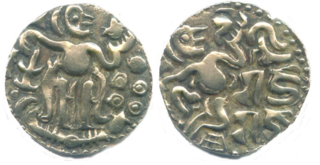
Rajadhiraja I was a Chola emperor, the most skilled military commander among the Chola rulers and the successor of his father, Rajendra I. He was the only Chola emperor who was killed while leading his army in war, and although he had a short reign, he helped his father conquer several territories as well as to maintain the Chola authority over most of Sri Lanka, Eastern Chalukya and Kalinga, among others. He also established imperial relations with overseas allies despite a series of revolts in the territory.

The Chola dynasty was a Tamil thalassocratic empire of southern India and one of the longest-ruling dynasties in the history of the world. The earliest datable references to the Chola are from inscriptions dated to the 3rd century BCE during the reign of Ashoka of the Maurya Empire. As one of the Three Crowned Kings of Tamilakam, along with the Chera and Pandya, the dynasty continued to govern over varying territories until the 13th century CE. The Chola Empire was at its peak under the Medieval Cholas in the mid-9th century CE.

Vikrama Chola, known as Kō Parakēsari Varman, was a 12th-century ruler of the Chola Empire in southern India. He succeeded his father Kulothunga I to the throne. Vikrama Chola was crowned as the heir-apparent by his father early in his life. He was appointed as viceroy of the Vengi province in 1089 C.E., succeeding his brother Rajaraja Chodaganga. Vikrama during his tenure successfully managed to check the ambitions of the Western Chalukya Vikramaditya VI on the Vengi kingdom.Vikrama Chola inherited the territories which included Tamil Nadu and some parts of Andhra Pradesh.

Kulothunga Chola II was a Chola Emperor from 1133 CE to 1150 CE. He succeeded Vikrama Chola to the throne in 1135 CE. Vikrama Chola made Kulothunga his heir apparent and coregent in 1133 CE, so the inscriptions of Kulothunga II count his reign from 1133 CE. According to historians Nilakanta Sastri and T.N Subramanian, Kulottunga Chola II was not the son of Vikrama Chola and they have suggested that there was a break in the line of succession.
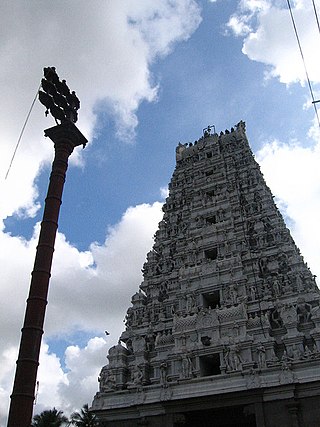
Uthiramerur is a panchayat town in Kancheepuram district in the Indian state of Tamil Nadu. It is situated 90 km south west of Chennai, the capital of Tamilnadu. It is noted for its temple inscriptions that describe a self-governance system existing around 7th to 9th century CE.
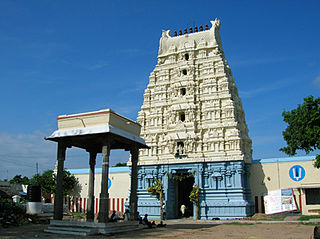
Sri Bhaktavatsala Perumal temple is a Hindu temple, located at Thirunindravur, a western suburb of Chennai, India. It is dedicated to the Hindu deity Vishnu. Constructed in the Dravidian style of architecture, the temple is glorified in the Naalayira Divya Prabandham, the early medieval Tamil canon of the Alvar saints from the 6th–9th centuries CE. It is one of the 108 Divya Desams dedicated to Vishnu, who is worshipped as Bhaktavatsala Perumal and his consort Lakshmi as Ennai Petra Thayar.
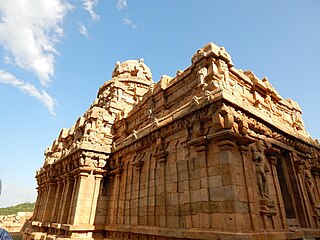
Narthamalai, a cluster of small hills, is 25 km from Trichy on the Trichy-Pudukottai highway in the state of Tamil Nadu, India. Here can be seen some of the oldest rock cut cave temples, as well as the longest rock-cut edicts, similar to Asokan edicts and extremely rare in the south of India. The town houses Vijayalaya Choleeswaram built during the 9th century. The two rock-cut temples are classic examples of how temple architecture styles were fusing in different parts of the country.

The Ashtabujakaram or Ashtabuja Perumal Temple located in Kanchipuram in the South Indian state of Tamil Nadu, is dedicated to the Hindu god Vishnu. Constructed in the Dravidian style of architecture, the temple is glorified in the Nalayira Divya Prabandham, the early medieval Tamil canon of the Alvar saints from the 6th–9th centuries CE. It is one of the 108 Divya Desams dedicated to Vishnu, who is worshipped as Ashta Bhuja Perumal and his consort Lakshmi as Alamelumangai.

Tiruvekkaa Temple or Yathothkari Perumal Temple is a Hindu temple located in Kanchipuram in the South Indian state of Tamil Nadu and dedicated to the Hindu god Vishnu. Constructed in the Dravidian style of architecture, the temple is glorified in the Naalayira Divya Prabandham, the early medieval Tamil canon of the Alvar saints from the 6th–9th centuries CE. It is one of the 108 Divya Desams dedicated to Vishnu, who is worshipped as Yathothkari Perumal, and his consort Lakshmi as Komalavalli.

Ulagalandha Perumal Temple is a temple dedicated to Vishnu located in Kanchipuram, Tamil Nadu, India. Constructed in the Dravidian style of architecture, the temple is glorified in the Naalayira Divya Prabandham, the early medieval Tamil canon of the Alvar saints from the 6th through 9th centuries CE. It is one of the 108 Divya Desams dedicated to Vishnu, who is worshipped as Ulagalantha Perumal, and his consort Lakshmi as Amuthavalli. The temple is believed to have been built by the Pallavas, with later contributions from the medieval Cholas, Vijayanagara kings, and Madurai Nayaks.

Karunakara Tondaiman was a general of Chola Emperor Kulottunga I. He is renowned for leading the Chola invasion of Kalinga during the reign of Kulottunga I and is the hero of Jayamkondar's poem Kalinkkattuparani In the Parani poem he is referred to as the lord of Vandai. while in the Draksharamam inscription of Kulottunga I, he is called as Vanduvaraja and Pallavaraja. He also served as a minister under Kulothunga Chola's son and successor, Vikrama Chola.

Sri Lakshmi Narasimhar Temple is located about 55 km from Chennai and 21 km from Arakkonam, in Narasingapuram, Thiruvallur. The temple is dedicated to Hindu deity Narasimha, who is avatar of Vishnu and his consort Lakshmi. From the days of glory and grandeur that prevailed in South India the temple of Lakhsmi Narasimha at Narasingapuram still boasts the era of Cholas and Vijayanagara Rayas. The Lakshmi Narasimha Temple is situated in the village of Narasingapuram in Thiruvallur district.
Ennayiram is a village in Vikravandi taluk in Villuppuram district in the Indian state of Tamil Nadu. The major occupation of the people living at this place is agriculture.
Rajagopala Perumal Temple is a Hindu temple located at Manimangalam, near Tambaram, a suburb of Chennai, India. The temple is dedicated to Vishnu.

The Sundaravarada Perumal Temple in Uthiramerur, a village in the South Indian state of Tamil Nadu, is dedicated to the Hindu god Vishnu. Constructed in the Dravidian style of architecture, the temple. Vishnu is worshipped as Sundaravarada Perumal and his consort Lakshmi as Anandavalli. The temple was originally built by Pallavas, with later additions from the Cholas, Pandyas, Sambuvarayas, Vijayanagara Rayas and the Nayaks.

The Vaikunta Perumal Temple in Kanchi, a village in the South Indian state of Tamil Nadu, is dedicated to the Hindu god Vishnu. The temple is constructed in the Dravidian style of architecture. Vishnu is worshipped as Vaikunta Perumal and his consort Lakshmi as Anandavalli. The temple was originally built by Pallavan, with later additions from the Chola. The temple is known for the inscriptions indicating the democratic practises of electing representatives for the village bodies during the regime of Parantaka Chola.
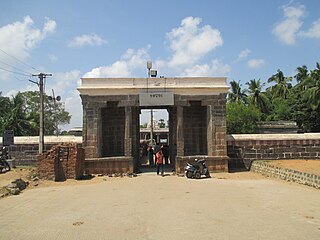
Nithyakalayana Perumal temple in Thiruvidandai, a village in Chennai, Chengalpattu district of the South Indian state of Tamil Nadu, is dedicated to Varaha, the boar avatar of the Hindu god Vishnu. Constructed in the Tamil style of architecture, the temple is glorified in the Naalayira Divya Prabandham, the early medieval Tamil canon of the Alvar saints from the 6th–9th centuries CE. It is one of the 108 Divya Desams dedicated to Vishnu, who is worshipped as Nithyakalayana Perumal (Varaha) and his consort Lakshmi as Komalavalli Thayar. The original structure of the temple was built by the Pallavas during the 7th century CE, with later additions from the Cholas during the 11th century.
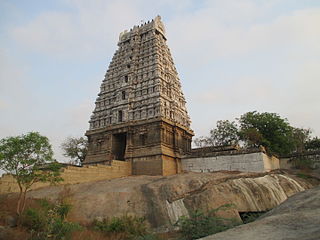
Atulya Nadheswarar Temple is a Hindu temple dedicated to the deity Shiva, located in Arakandanallur in Thirukoilur taluk, a town panchayat in Viluppuram district in the South Indian state of Tamil Nadu. Shiva is worshipped as Atulya Nadheswarar, and is represented by the lingam. His consort Parvati is depicted as Azhagiya Ponnazhagi. The presiding deity is revered in the 7th century Tamil Saiva canonical work, the Tevaram, written by Tamil saint poets known as the Nayanars and classified as Paadal Petra Sthalam.

















